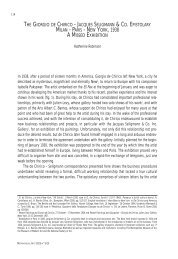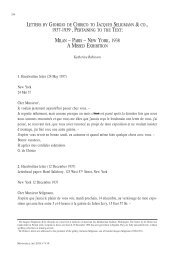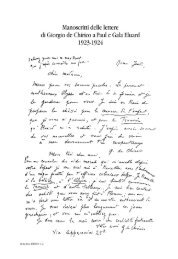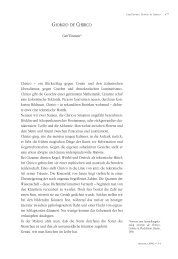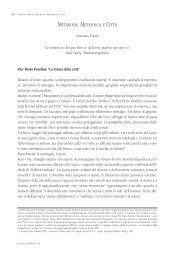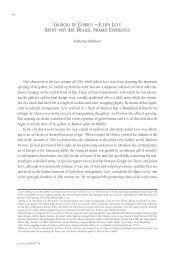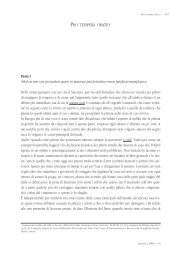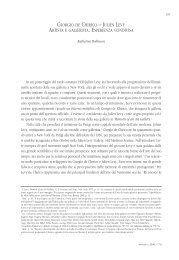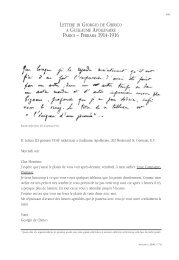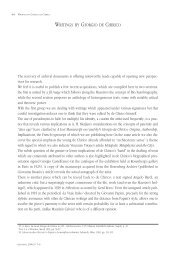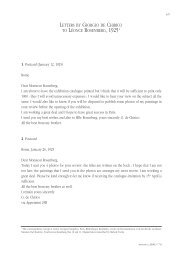Emplastic Oil - Fondazione Giorgio e Isa de Chirico
Emplastic Oil - Fondazione Giorgio e Isa de Chirico
Emplastic Oil - Fondazione Giorgio e Isa de Chirico
You also want an ePaper? Increase the reach of your titles
YUMPU automatically turns print PDFs into web optimized ePapers that Google loves.
164<br />
SALVATORE VACANTI: FROM MURAL PAINTING TO “EMPLASTIC OIL”<br />
fig. 4 A. Savinio, Creta, 1932, tempera and oil on canvas,<br />
Galleria d’Arte Mo<strong>de</strong>rna, Rome<br />
The artists were asked to participate in a collective<br />
and social-min<strong>de</strong>d un<strong>de</strong>rtaking, engen<strong>de</strong>ring<br />
the flashpoint in the <strong>de</strong>bate on the rebirth of<br />
mural painting in Italy and its techniques. <strong>Giorgio</strong><br />
<strong>de</strong> <strong>Chirico</strong> was invited to realize a large mural<br />
painting in the Salone <strong>de</strong>lle Cerimonie (Hall of<br />
Ceremonies), together with Campigli, Funi,<br />
Severini and Sironi himself. The work, entitled<br />
Cultura italiana (Italian Culture) (figs. 2-3), was<br />
executed on fifteen square metres on the back wall<br />
of the Hall opposite of Sironi’s solemn wall-painting,<br />
and was documented in reproductions published<br />
in magazines of the period. 18 The mural<br />
painting framed iconographical elements typical of<br />
<strong>de</strong> <strong>Chirico</strong>’s recent production: the horse-statue,<br />
fragments of Greek temples, a cast of a Hellenistic<br />
head, the painter at his easel. In the background<br />
were symbols of Florence, Bologna and Rome, whilst the scene was peopled with poets, literati,<br />
painters, sculptors and musicians, with <strong>de</strong>tails reminiscent of the costumes that he was then preparing<br />
for Vicenzo Bellini’s I Puritani, commissioned by the Maggio Musicale Fiorentino. The painter<br />
so recounts the un<strong>de</strong>rtaking:<br />
During this period I executed a large mural painting at the Palazzo <strong>de</strong>lla Triennale in Milan. I executed<br />
it very quickly and in extremely difficult circumstances, using the egg tempera process, and this<br />
painting cost me the sum of 150 lire in eggs alone. […] My mural painting gave rise to much envy; it<br />
was not reproduced in the newspapers or even in the illustrated leaflets […]. After the exhibition had<br />
en<strong>de</strong>d, all the paintings in this room were <strong>de</strong>stroyed, probably because they did not dare, owing to<br />
possible scandal, to <strong>de</strong>stroy just mine. 19<br />
In reality, all the works were later <strong>de</strong>stroyed because they were originally inten<strong>de</strong>d to be temporary.<br />
From a practical standpoint, Sironi’s first great attempt in mural painting was ultimately a<br />
failure as all works displayed alterations before long. 20 The problem partly arose because of the limited<br />
time allotted to execution and also due to the lack of proper technical preparation in mural<br />
painting by any of the artists (including <strong>de</strong> <strong>Chirico</strong>). In<strong>de</strong>ed, the technique of “buon fresco” 21 had<br />
18<br />
See M. Fagiolo <strong>de</strong>ll’Arco, op. cit. 1995, pp. 140-142.<br />
19<br />
G. <strong>de</strong> <strong>Chirico</strong>, The Memoirs…, cit., p. 127.<br />
20<br />
See G. Germani. La pittura murale italiana nel Novecento: tecniche e materiali, in Le pitture murali, edited by C. Danti, M. Matteini, A. Moles, Centro<br />
Di, Florence 1990. pp. 103-120.<br />
21<br />
Originally, fresco was carried out with mineral pigments which are simply diluted in water and is secured by the carbonation of calcium hydrate.<br />
With significant regional variations, it is, since antiquity, the most well known technique for mural painting. The systematic procedure prescribes a<br />
METAPHYSICAL ART 2010|N° 9/10



